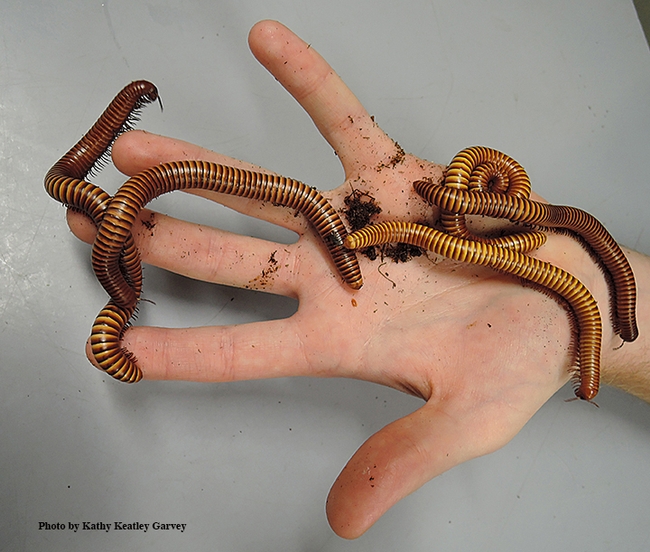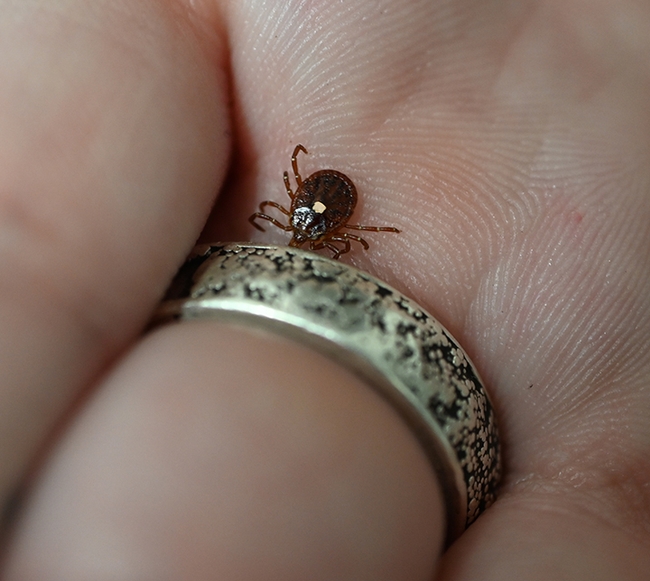- Author: Kathy Keatley Garvey
Visitors at the Bohart Museum of Entomology open house learned about such "household vampires" as mosquitoes, fleas, lice, ticks and bedbugs, and many also participated in the family arts-and-crafts activities.
The artsy-craftsy activities, a traditional part of all the Bohart Museum open house, are also educational and informative. At the Sept. 23 open house, UC Davis entomology students introduced visitors to (1) collecting tiny insects and then viewing them under a microscope and (2) making insect collecting or "kill" jars.
Bohart intern Melody Ruiz, a third-year entomology major at UC Davis, demonstrated "Clear Packing Tape Art" as a way to collect tiny insects and view them under a microscope, while UC Davis entomology senior Sol Wantz, president of the Entomology Club, showed participants how to make insect collecting jars or "kill" jars.
For the collecting jar or "kill" jars, Wantz explained:
- Get a clean wide-mourth jar with a lid
- Add some plaster to the bottom
- Add some water so it is like pancake batter
- Swirl it around to mix
- Let air dry (15 minutes to a day)
- Add a teaspoon of poison-like nail polish remover (acetone or ethyl acetate). The plaster absorbs this.
- Add in a tissue so the insects don't bump into each other.
- Add an insect or insects.
- Seal the jar and the insect(s) should die within a few minutes
- They are ready to be pinned for a collection
An 11-part YouTube video series by the UC Davis Department of Entomology and Nematology explains "How to Make an Insect Collection." The "kill jar" procedure is here.
The Entomology Club, advised by forensic entomologist Robert Kimsey of the Department of Entomology and Nematology, meets Thursdays at 6 p.m. in 122 Briggs. The meetings are open to all interested persons, Kimsey said.
Ruiz staffed the "Clear Packing Tape Art" table and provided insect nets. She noted that clear packing tape is a good way to collect and see tiny insects. "Use a strip of clear packing tape. Put the sticky side down on your pillow, couch, clothes, skin, etc. Then place that same tape onto a white piece of paper. Write down the date, where it was collected from, and your name. Look at your project through a microscope."
Also popular at the open house was the Lepidoptera specimen collection, curated by entomologist Jeff Smith; and the live insect petting zoo, featuring Madagascar hissing cockroaches, aka "hissers," and stick insects, aka "walking sticks."
The Bohart Museum, directed by UC Davis distinguished professor Lynn Kimsey, houses a global collection of eight million insect specimens, plus the insect petting zoo and an insect-themed gift shop. The museum is located in Room 1124 of the Academic Surge Building, 455 Crocker Lane,. UC Davis.
The next open house, themed "Monarchs," is set for Saturday, Nov. 4 from 1 to 4 p.m. All open houses are free and family friendly. For more information, contact the Bohart Museum at bmuseum@ucdavis.edu or telephone (530-752-0493.
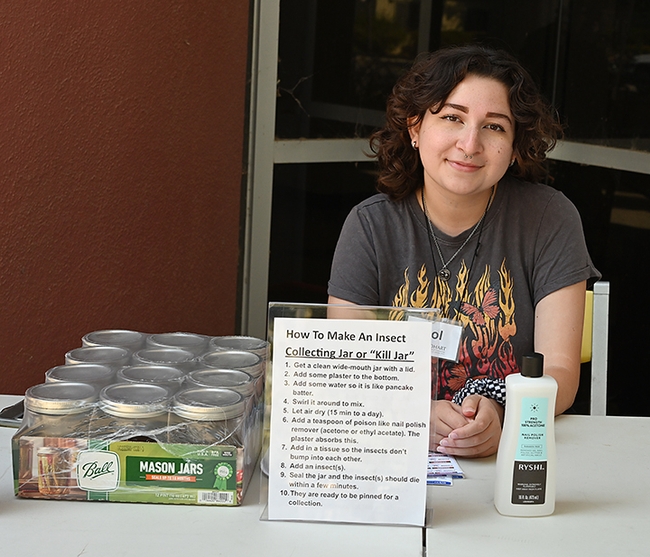
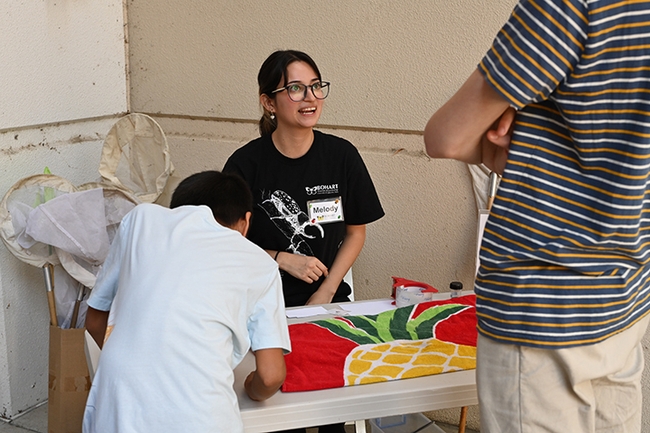

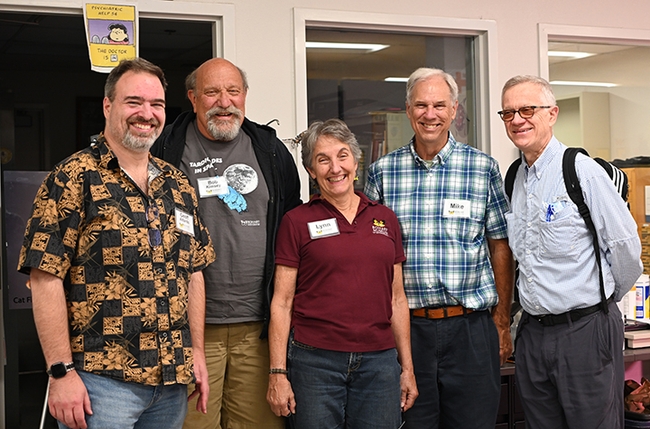
- Author: Kathy Keatley Garvey
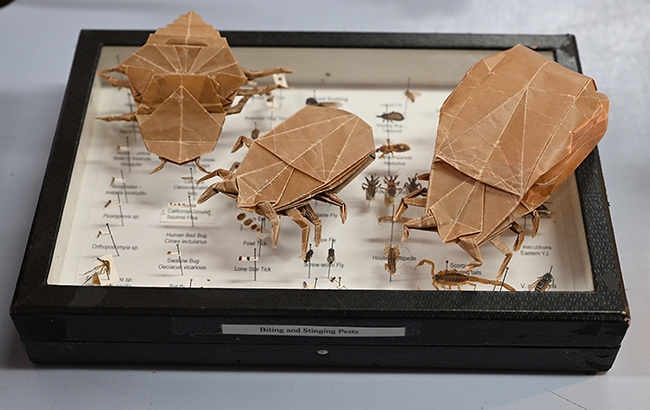
They learned that "medical entomologist is the study of arthropods (such as insects and ticks) that spread pathogens that cause human disease. It is also important to study insects and arthropods that spread diseases to other animals! This field o study is called veterinary entomology. Some diseases affect both humans and animals. This is called a zoonotic disease." (from Bohart Museum poster)
They asked questions. They observed "the vampires" through microscopes. And they left with first-hand information.
The presenters included:
-
Robert "Bob" Kimsey, forensic entomologist, Department of Entomology and Nematology, who answered questions about medical entomology.
-
Luz Maria Robles, public information officer, Sacramento-Yolo Mosquito and Vector Control District, who discussed and displayed mosquitoes and how to keep yourself safe. See https://www.fightthebite.net/
- Carla-Cristina "CC" Melo Edwards, doctoral student and mosquito researcher in the laboratory of medical entomologist-geneticist Geoffrey Attardo, associate professor of entomology, UC Davis Department of Entomology and Nematology, who fielded questions about mosquitoes. Attardo displayed enlarged images of mosquitoes, including a blood-fed Aedes aegypti, and a female and male Culex tarsalis.
- Moriah Garrison, senior entomologist and research coordinator with Carroll-Loye Biological Research (CLBR), (owned by doctoral scientists Scott Carroll and Jenella Loye, affiliated with the Department of Entomology and Nematology), displayed live ticks and mosquitoes.
- Nazzy Pakpour, UC Davis alumna, Novozymes scientist and author, displayed her newly published children's book, Please Don't Bite Me
For the occasion, UC Davis alumnus Kevin Murakoshi, gifted the Bohart Museum a trio of origami sculptures: a tick, an engorged tick and a bedbug. At an earlier open house, he presented the museum with origami sculptures of praying mantises. "They're beautiful," said UC Davis distinguished professor Lynn Kimsey, director of the Bohart Museum. "We're going to display them in our hallway."
The museum houses a global collection of eight million insect specimens, plus a live insect petting zoo (including Madasgascar hissing cockroaches and walking sticks), and a gift shop. It is located in Room 1124 of the Academic Surge Building, 455 Crocker Lane. UC Davis.
The next open house, themed "Monarchs," is set for Saturday, Nov. 4 from 1 to 4 p.m. All open houses are free and family friendly and include a family arts-and-crafts activity. For more information, contact the Bohart Museum at bmuseum@ucdavis.edu or telephone (530-752-0493.
(Part 2 of the open house will be published Friday, Sept. 29)
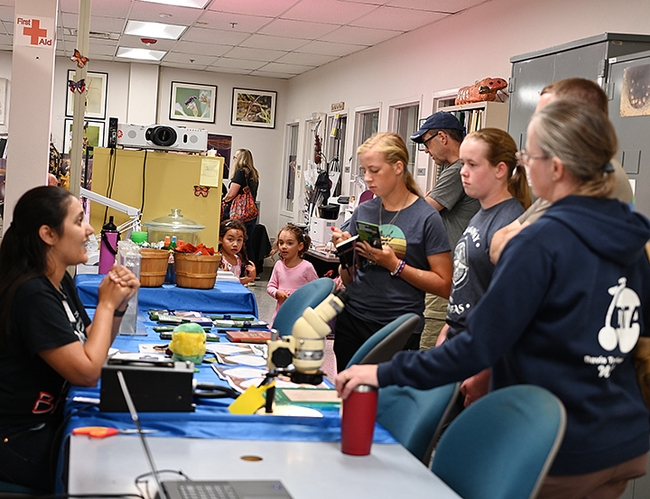
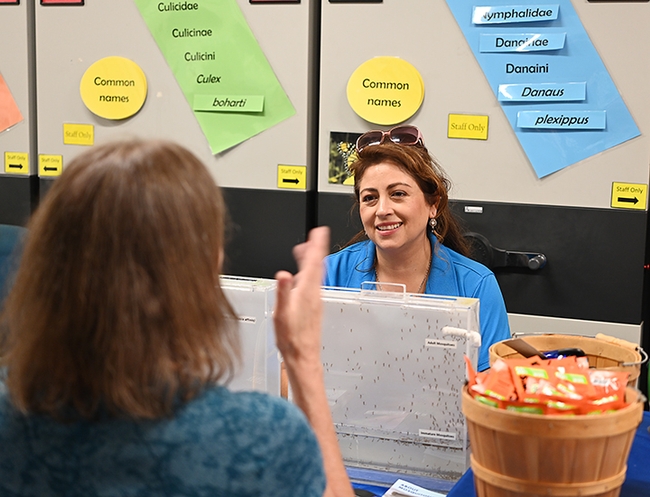
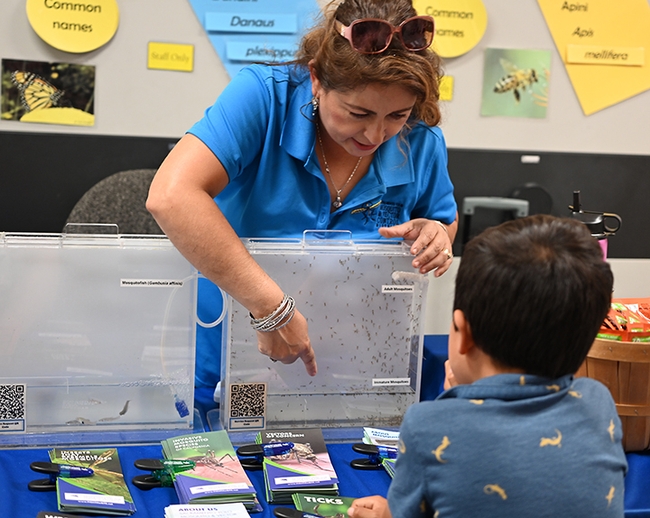
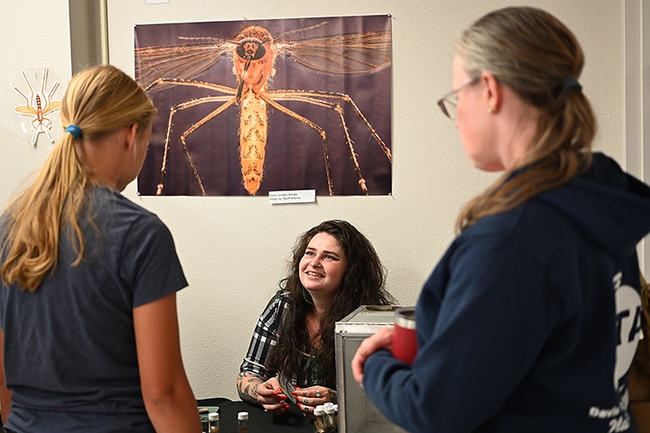
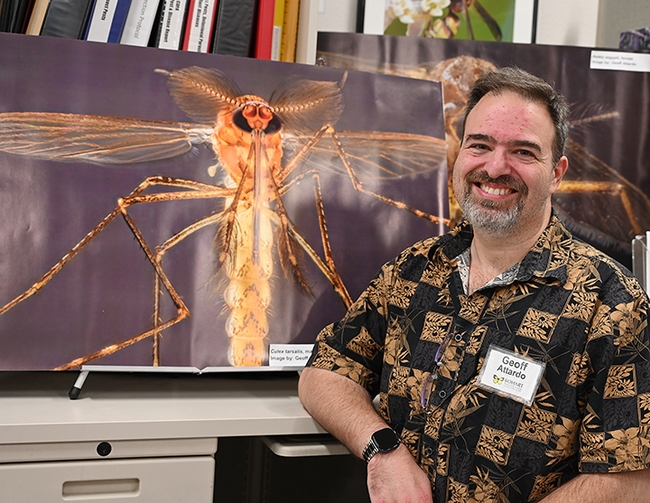
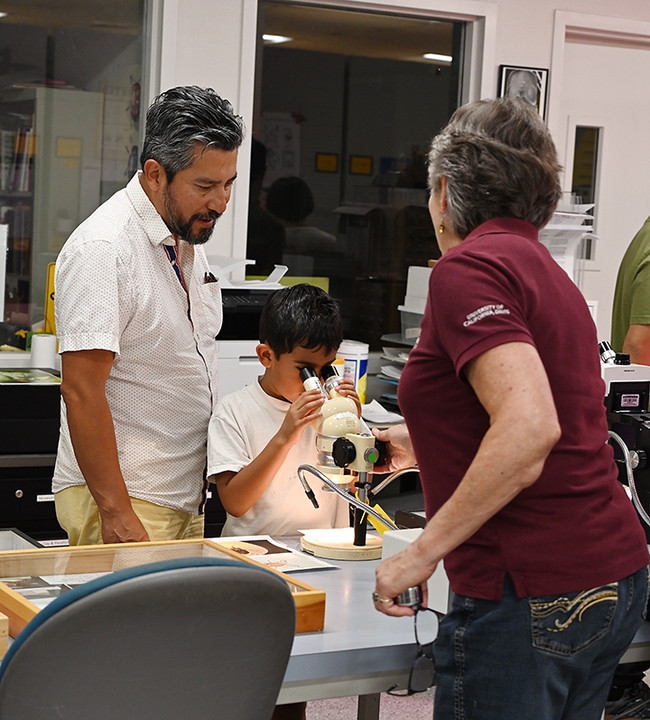
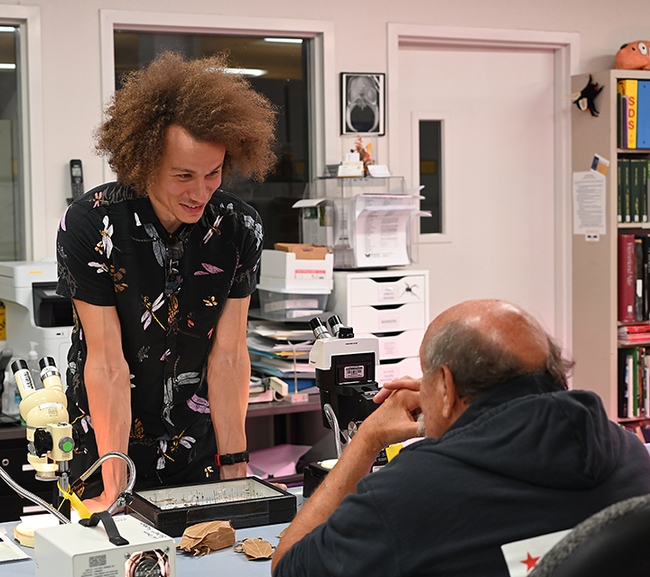
- Author: Kathy Keatley Garvey

Sunday, Aug. 27: Praying Mantises
Saturday, Sept. 23: Household Vampires
Saturday, Nov. 4: Monarchs
The open houses, free and family friendly, take place from 1 to 4 p.m. in the insect museum, located in Room 1124 of the Academic Surge Building, 455 Crocker Lane, UC Davis campus. Parking is free.
At each event, the focus is on the special theme, and there's also a family arts-and-crafts activity. You can see insect displays and hold the Madagascar hissing cockroaches and stick insects from the live petting zoo.
The museum, founded in 1946, is directed by UC Davis distinguished professor Lynn Kimsey. It houses a global collection of eight million insect specimens. In addition to the petting zoo, it houses a year-around, insect-themed gift shop.
Meanwhile, how many praying mantises (or praying mantids) have you seen this year? Or in past years?
What were they eating?
This mantis is a Stagmomantis limbata, as identified by Lohit Garikipati, a UC Davis alumnus studying for his master's degree at Towson University, Md.
It nailed a cabbage white butterfly, Pieris rapae. As a caterpillar, P. rapae is a major pest of cole crops such as cabbage.
This time the menu did not include "bee."
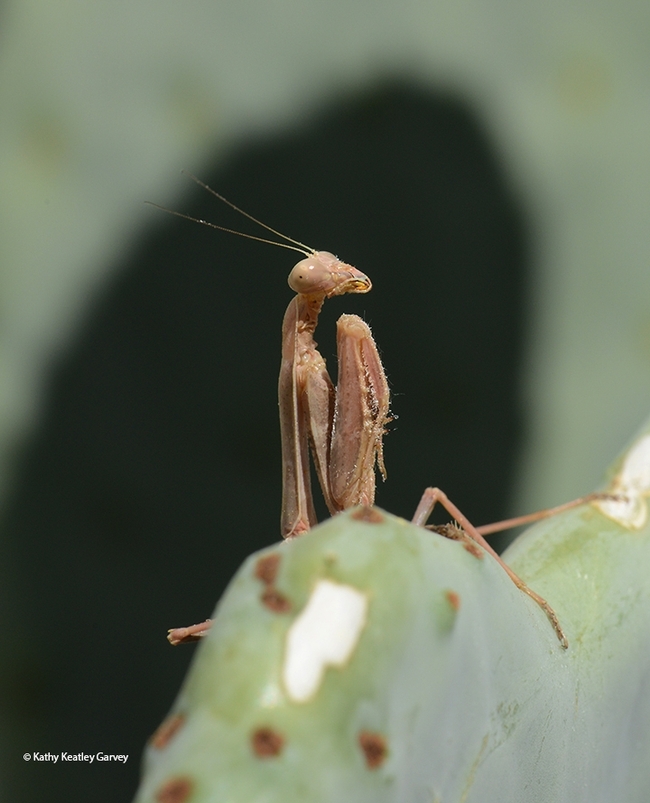
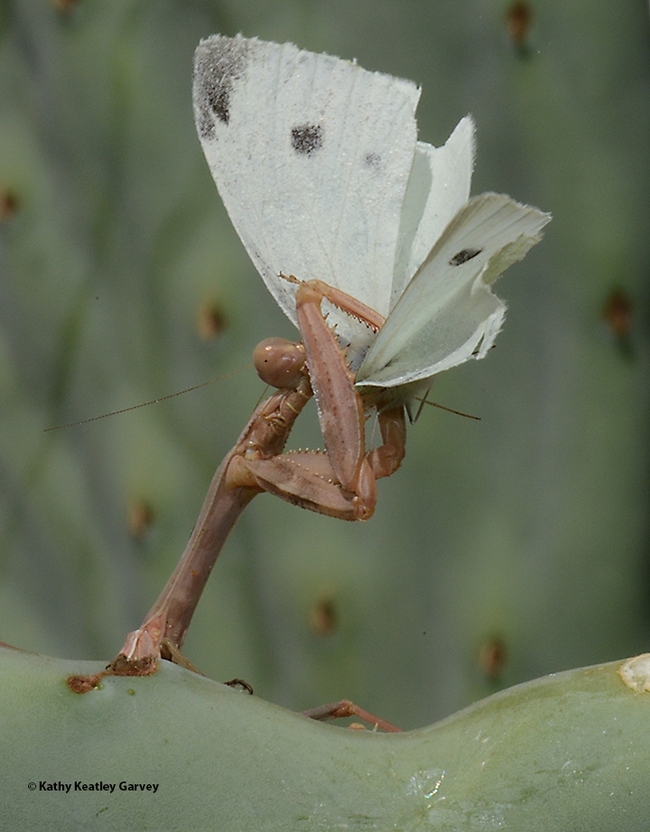
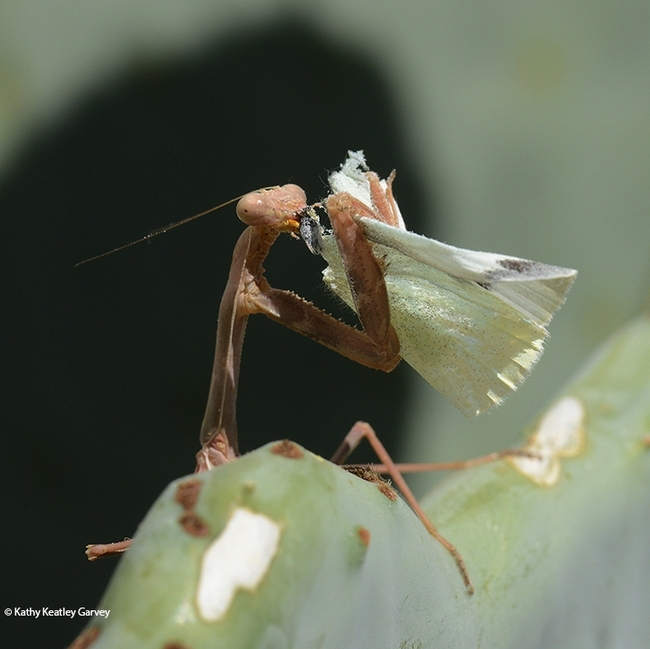
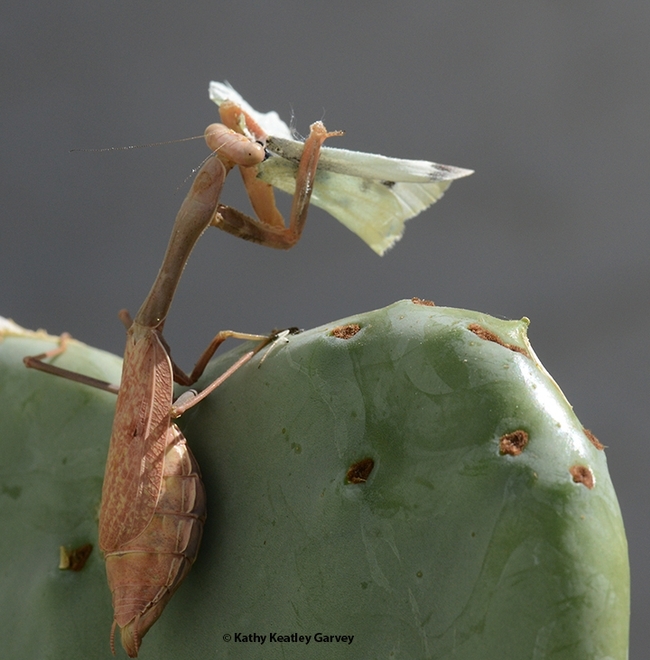
- Author: Kathy Keatley Garvey
When the Bohart Museum of Entomology hosted an open house, "An Evening at the Museum," on Saturday, July 22, showcasing moths and flies, the moth experts were there to celebrate National Moth Week, July 22-30 and the fly experts had just attended the 10th International Dipterology Congress, held July 16-21, in Reno.
But just as the Bohart Museum houses a global collection of 8 million insect specimens, international scientists were there representing a number of countries, including Greece, Ukraine, Iran and Spain, as well as the United States.
Among the fly experts participating in the Bohart Museum's open house was tephritid fruit fly expert Nikos Papadopoulos of Greece, professor of applied entomology, who directs the laboratory of Entomology and Agricultural Zoology at the University of Thessaly. He shared a video ontephritid flies and answered questions. Professor Papadopoulos obtained his PhD in 1999 (Aristotle University of Thessaloniki), and did postdoctoral work (2001-2003) at UC Davis, before joining the University of Thessaly. He collaborates with UC Davis distinguished professor James R. Carey. (See his biosketch)
Postdoctoral researcher Severyn Korneyev, a Ukrainian entomologist who studies flies, showed specimens and fielded questions. He holds a joint postdoc position with the UC Davis Department of Entomology and the California Department of Food and Agriculture. A member of the Ukrainian Entomological Society and the Entomological Society of America, Korneyev specializes in the systematics and taxonomy of the true fruit flies (Diptera: Tephritidae). His expertise includes morphological and molecular diagnostics, collection management, and the field collecting of insects. (See Bug Squad blog)
Professor Miguel Angel Miranda of the University of the Balearic Islands (UBI), Spain, showed specimens and led insect-drawing workshops. A zoologist, entomologist and noted insect illustrator, he currently teaches zoology, parasitology, and biotechnology applied for pest control. He is a member of UBI's Applied Zoology and Animal Conservation Research Group or ZAP. See Bug Squad blog)
Iranian-American scientist Nazzy Pakpour, who received her bachelor's degree in entomology from UC Davis and her doctorate in microbiology, virology, and parasitology from the University of Pennsylvania, read from her newly published children's book, Please Don't Bite Me. Her UC Davis connections including serving as a postdoctoral scholar in the mosquito research lab of Professor Shirley Luckhart, now with the University of Idaho.
The Bohart Museum, established in 1946 by noted entomologist Richard M. Bohart of UC Davis, is directed by UC Davis distinguished professor Lynn Kimsey. It is located in Room 1124 of the Academic Surge Building, 455 Crocker Lane. The insect museum is open to the public for summer hours from 2 to 5 p.m. on Tuesdays. It also maintains a live insect petting zoo (Madagascar hissing cockroaches, stick insect and tarantulas) and an insect-themed gift shop.
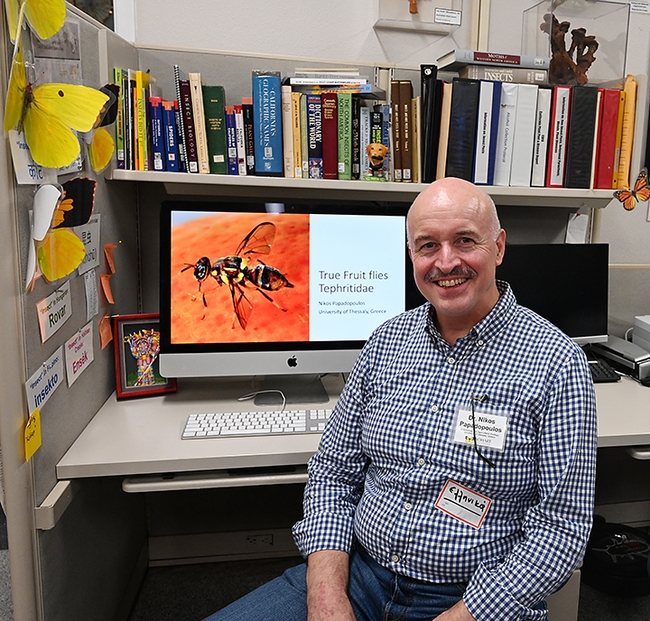
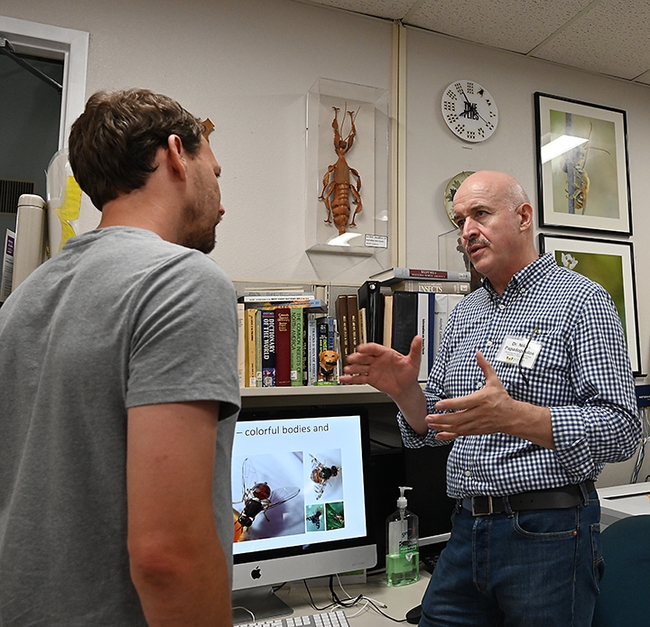
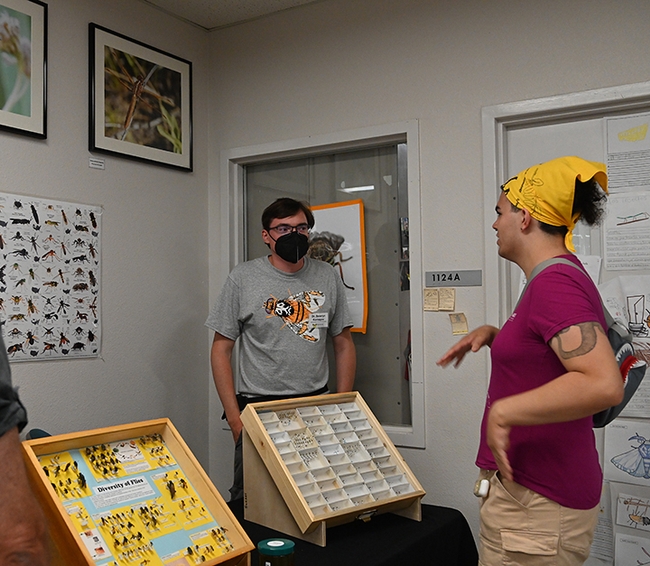
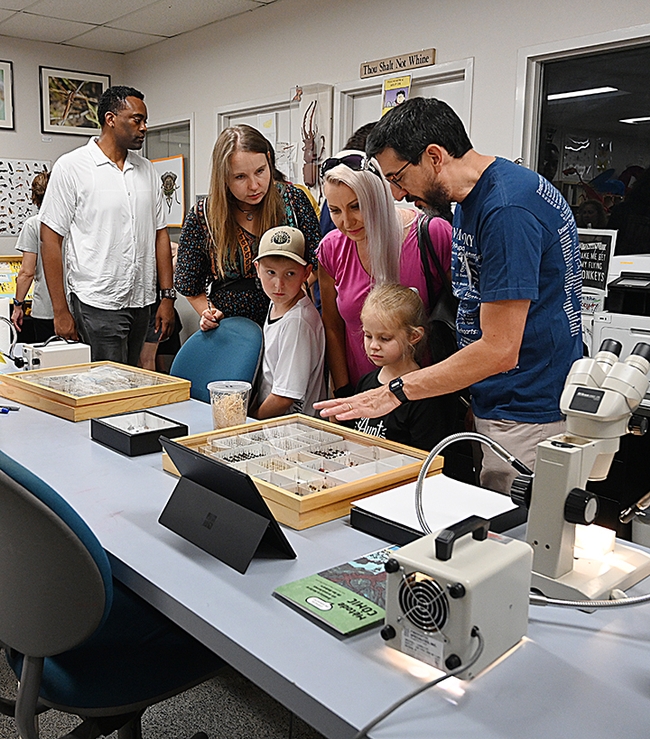
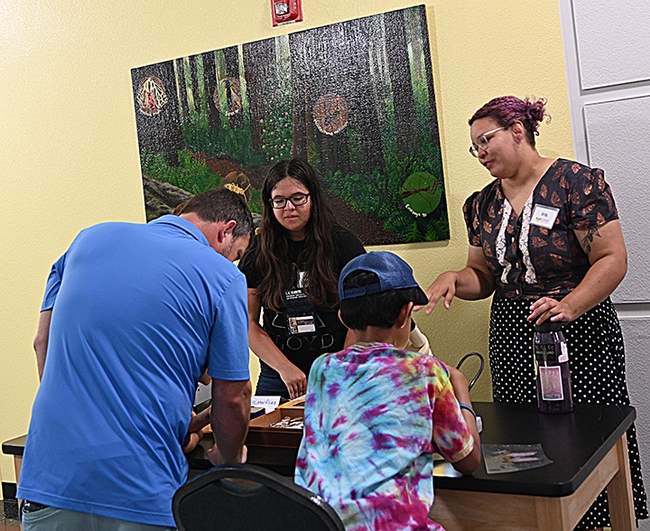
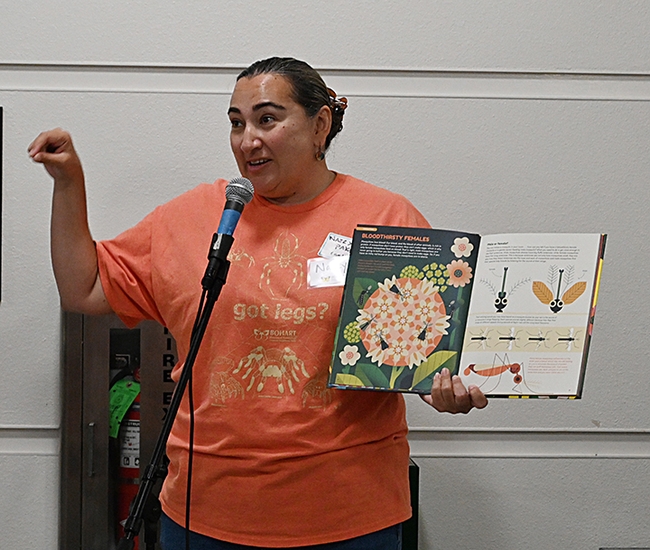
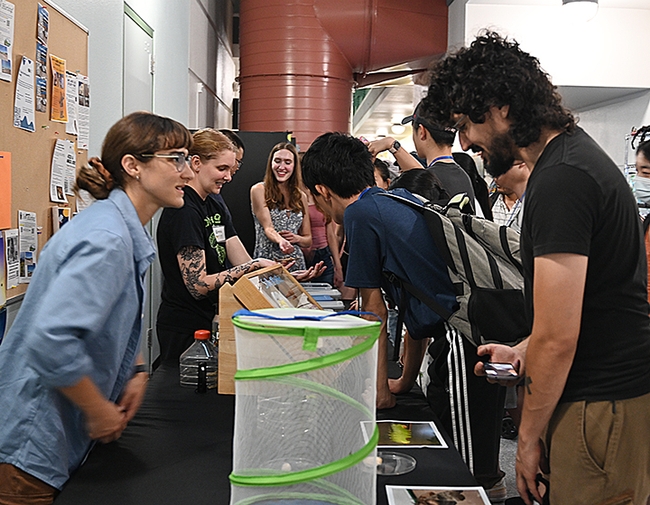
- Author: Kathy Keatley Garvey

If you said "14," go to the head of the class.
Is it an insect? No, it's a crustacean.
When the Bohart Museum of Entomology hosts an open house on "Many-Legged Wonders" from 1 to 4 p.m., Saturday, March 18, among the critters showcased will be spiders, millipedes, centipedes, scorpions, tarantulas, and yes, isopods.
The event, free and family friendly, takes place in Room 1124 of the Academic Surge Building, 455 Crocker Lane, UC Davis campus.
Elijah Shih, a third-year UC Davis transfer student studying neurobiology, physiology and behavior, will show his isopods. “Isopods come in many morphs and sizes," he says. "There are many colorful and beautifully patterned isopods, some natural, some man made. Isopods are crustaceans and require moisture to breathe and molt properly. Some species have the ability to conglobate or roll up in to the ball where as others do not. They are great for helping create a bioactive system for reptiles, planted tanks, and a great feeder for young reptiles and amphibians.”
“There are many isopod species in the world," Shih related, “and at least five common isopod species that are found in California: Porcellio laevis, Porcellio scaber, Armadillidium vulgare, Porcellio dilatatus, and Cubaris marina. Their morphs are considered wild type.”
Shih, who hopes to pursue a career in veterinary medicine, said he houses “many reptiles, both aquatic and terrestrial, such as the box turtle and gargoyle gecko. I wanted to create bioactive environments for my reptiles—(mainly to not have to pick up the feces)-- so I looked for ways to make that possible. I need something that was small, agile, prolific, and safe to be eaten. Isopods, better known as Rollie pillows or pill bugs, are the best solution for me. I had my isopods, but to complete the cleanup crew, I added springtails to help clean up any leftover food, but more importantly, the mold.”
Tabatha Yang, education and outreach coordinator for the Bohart, announced that doctoral candidates Emma Jochim and Xavier Zahnle of the Jason Bond arachnology lab will dispel myths about spiders and millipedes at a question-and-answer session from 1 to 1:30. Doctoral student Iris Quayle will moderate.
From 1:30 to 4 p.m., will be the general open house with a showing of live animals and specimens. Bohart Museum research associate Brittany Kohler, the "zookeeper" of the Bohart petting zoo, says the current residents include:
- Princess Herbert, a Brazilian salmon-pink bird-eating tarantula (Lasiodora parahybana), age estimated to be around 20 (current oldest resident)
- Peaches, a Chilean rose hair tarantula (Grammostola rosea)
- Coco McFluffin, a Chaco golden knee tarantula (Grammostola pulchripes)
- Beatrice, a Vietnamese centipede (Scolopendra subspinipes), newest resident
- Two black widows (Latrodectus hesperus)
- One brown widow (Latrodectus geometricus)
Among the other residents are Madagascar hissing cockroaches, a giant cave cockroach, stick insects, a bark scorpion and ironclad beetles. A family arts-and-crafts activity is also planned.
The Bohart Museum, directed by UC Davis distinguished professor Lynn Kimsey, houses a global collection of eight million insect specimens, plus the petting zoo and a gift shop stocked with insect-themed books, posters, jewelry, t-shirts, hoodies and more. Dedicated to "understanding, documenting and communicating terrestrial arthropod diversity," the Bohart Museum was founded in 1946 and named for UC Davis professor and noted entomologist Richard Bohart. The insect museum is open to the public Mondays through Thursdays, from 8 a.m. to noon, and 1 to 5 p.m.
More information is available on the Bohart website at https://bohart.ucdavis.edu or by emailing bmuseum@ucdavis.edu.


